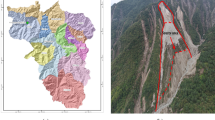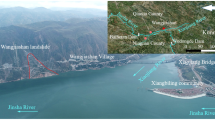Abstract
As the traditional displacement value of a landslide is very easy to be affected by rainfall, it is very difficult to establish a stable and uniform destabilized criterion of landslide in terms of the displacement value. So, it determines that establishment of an effective and stable dynamic displacement prediction parameter is very important in forecast of the debris landslides caused by rainfall. In order to determine this kind of prediction parameter, this paper first completes analysis on the relationship between the destabilized mechanism of the debris landslide and the rainfall dynamic rules. The relationship above shows that the periodical change value of rainfall can be taken as the dynamic unload–load parameter (ULP) of landslide, and the homologous change value of mensal landslide displacement can be taken as the stability displacement response parameter (DRP). Then, on the basis of the relationship between the ULP and the stability DRP of this kind of landslide, the unload–load displacement response ratio (ULDRR) appraisal parameter of this kind of landslides is established in this paper. Finally, the stability of typical debris landslides in China has been systematically studied by means of ULDRR appraisal parameter and model. We find that the ULDRR values conform to the evolutional rule of slope deformation and instability. So, it has been proved that the ULDRR parameter and the appraisal model are suitable and effective for prediction and evaluation of stability and evolution rule of rainfall-induced landslides.











Similar content being viewed by others
References
Baker R (2003) Inter-relations between experimental and computational aspects of slope stability analysis. Int J Numer Anal Methods Geomech 27(5):379–401
Beek VL, Asch VT (1998) Quantification of diffuse landslide by derivation of a general hydrological slope in stability threshold. In: 8th international IAGE congress, pp 899–906
Belle P, Aunay B, Bernardie S et al (2014) The application of an innovative inverse model for understanding and predicting landslide movements. Landslides 11(3):343–355
Bui DT, Pradhan B, Lofman O et al (2013) Regional prediction of landslide hazard using probability analysis of intense rainfall in the Hoa Binh province, Vietnam. Int J Nat Hazards 66(2):707–730
Crosta G, Frattini P (2001) Rainfall threshold for triggering soil slips and debris flow. In: Proceedings of the 2nd EGS Plinius conference on mediterranean storms. Siena, Italy, pp 463–487
Crozier MJ, Eyles RJ (1980) Assessing the probability of rapid mass movement. In: Proceedings of the 3rd Australian New Zealand Conference on Geomechanics. Int J Wellington: New Zealand Institute of Engineers, pp 247–251
Deng JL (1985) Grey control system (M). Huazhong College of Technology press, Wuhan, pp 343–347 (in Chinese)
He KQ, Zhou DY, Wang SJ (2004) Features of load–unload response ratio and its significance in predication of debris landslide induced by rainfall. J Rock Mech Eng 23(16):2665–2670 (in Chinese)
He KQ, Yang JB, Wang SJ (2007) The dynamic theory of the displacement of the debris landslide and its application (M). Science Press, Beijing, pp 165–175 (in Chinese)
He KQ, Wang SQ, Du W et al (2010) Dynamic features and effects of rainfall on landslides in the Three Gorges Reservoir region, China: using the Xintan landslide and the large Huangya landslide as the examples. Environ Earth Sci 59(6):1267–1274
Iverson RM, George DL, Allstadt K et al (2015) Landslide mobility and hazards: implications of the 2014 Oso disaster. Earth Planet Sci Lett 412:197–208
Kanungo DP, Sharma S (2014) Rainfall thresholds for prediction of shallow landslides around Chamoli–Joshimath region, Garhwal Himalayas, India. Landslides 11(4):629–638
Khan YA, Lateh H, Baten MA et al (2012) Critical antecedent rainfall conditions for shallow landslides in Chittagong City of Bangladesh. Environ Earth Sci 67(1):97–106
Liu SY, Shao LT, Li HJ (2015) Slope stability analysis using the limit equilibrium method and two finite element methods. Comput Geotech 63:291–298
Michiue M (1985) A method for predicting slope failures on cliff and mountain due to heavy rain. Nat Disaster Sci 7(1):1–12
Robbins JC (2016) A probabilistic approach for assessing landslide-triggering event rainfall in Papua New Guinea, using TRMM Satellite precipitation estimates. J Hydrol 541:296–309
Saito M (1969) Forecasting time of slope failure by tertiary creep. In: Proceedings of the 7th international conference on soil mechanics and foundation engineering, Mexico City, vol 2, pp 677–683
Wang FD (1995) Preliminary study on correlation between the characteristics of landslide shallow accumulation and rainfall precipitation. Hydrogeol Eng Geol 1:21–23 (in Chinese)
Wang NS (2006) Discuss on a method of landslide displacement dynamic prediction. West-China Explor Eng 122:269–271 (in Chinese)
Wu SY, Huang B, Liu RJ (2013) Study about mechanic parameter of slope rock mass’ structure plane. Appl Mech Mater 368–370:1551–1555
Zhang Z, Li SH, Ma L (2005) Probability analysis of relationship between landslide and rainfall in Chongqing area. Chin J Rock Mech Eng 24:3185–3191 (in Chinese)
Zhong YQ (1998) Landslide related to rainfall and its forecasting. Chin J Geol Hazard Control 9(4):81–86 (in Chinese)
Acknowledgements
The study was supported by National Natural Science Foundation of China (41372297). Mr. Yan Xueqing, postgraduate Guo Lu has done much significant work in analysis of data in this paper. The authors appreciate them very much for the work and achievement that they have done.
Author information
Authors and Affiliations
Corresponding author
Rights and permissions
About this article
Cite this article
Keqiang, H., Min, Z., Yongjun, Z. et al. Unload–load displacement response ratio parameter and its application in prediction of debris landslide induced by rainfall. Environ Earth Sci 76, 55 (2017). https://doi.org/10.1007/s12665-016-6372-0
Received:
Accepted:
Published:
DOI: https://doi.org/10.1007/s12665-016-6372-0




